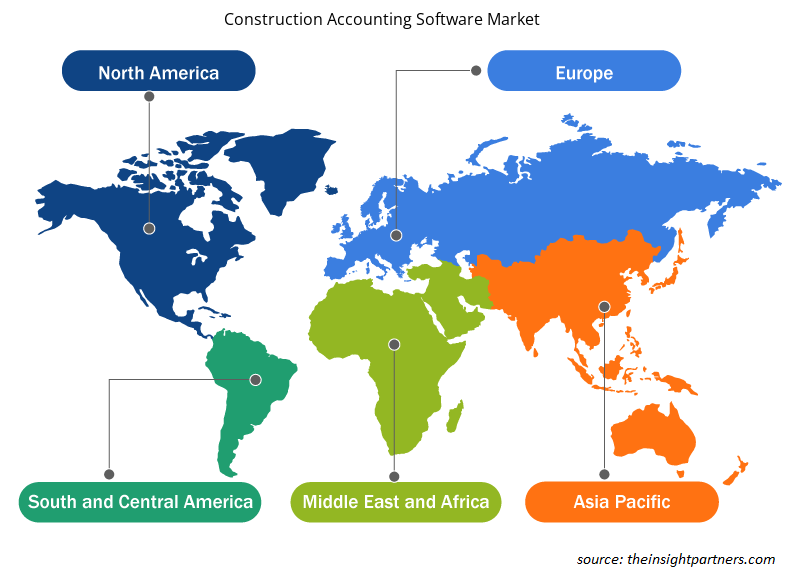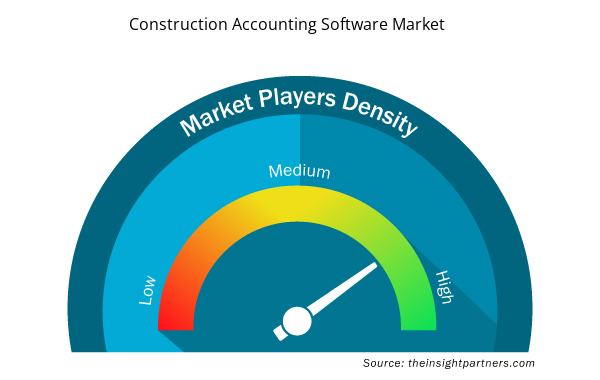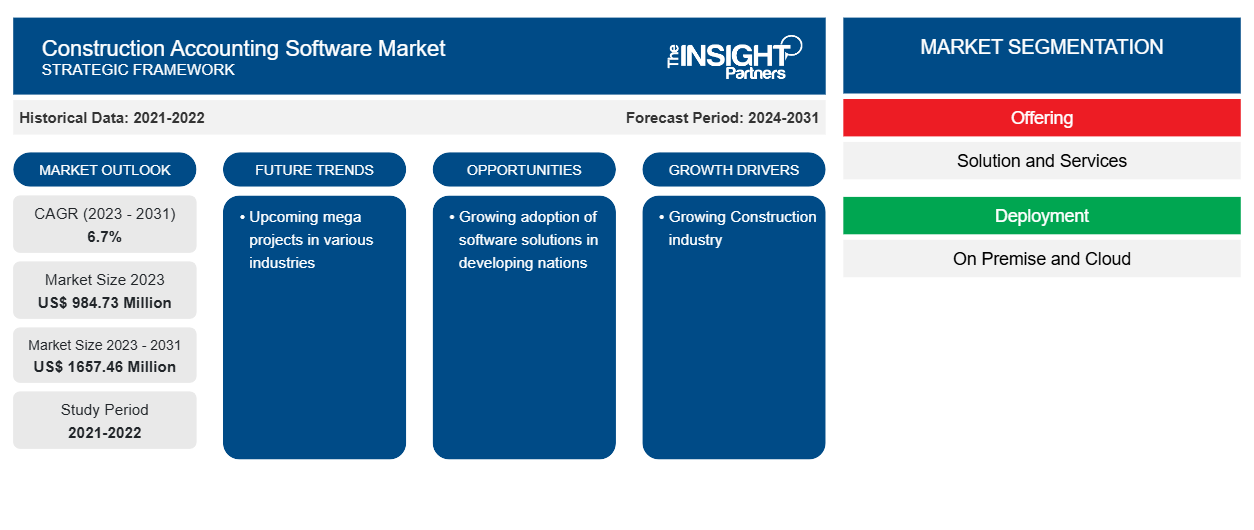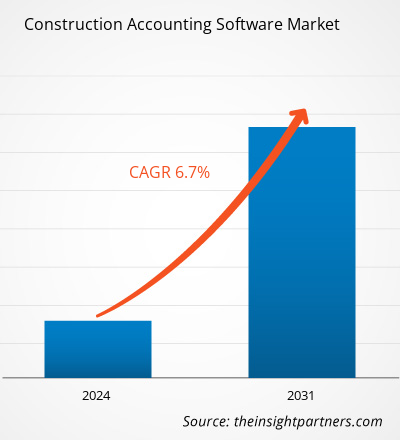من المتوقع أن يصل حجم سوق برامج المحاسبة للبناء إلى 1657.46 مليون دولار أمريكي بحلول عام 2031 من 984.73 مليون دولار أمريكي في عام 2023. ومن المتوقع أن يسجل السوق معدل نمو سنوي مركب بنسبة 6.7٪ خلال الفترة 2023-2031. ومن المرجح أن يظل التحول الرقمي المتزايد في صناعة البناء وصناعة البناء الصاعدة من الاتجاهات الرئيسية في السوق.
تحليل سوق برامج المحاسبة للإنشاءات
إن الطلب المتزايد من القطاعات السكنية والتجارية يغذي صناعة البناء المتنامية. وهذا العامل يؤدي إلى اعتماد برامج المحاسبة للبناء من قبل الإدارة المالية لشركات البناء. يساعد البرنامج شركات البناء على تتبع الأموال الداخلة والخارجة من أعمالها بدقة. يتعامل البرنامج مع جوانب صناعة البناء، مثل تكلفة الوظائف والاحتفاظ بها. تؤدي مثل هذه الميزات في برامج المحاسبة للبناء إلى اعتمادها.
نظرة عامة على سوق برامج المحاسبة للإنشاءات
توفر برامج المحاسبة الخاصة بالإنشاءات أدوات إدارة مالية للشركات الصغيرة والمتوسطة الحجم وشركات الإنشاءات الكبيرة لمشاريع وأنشطة الإنشاءات. يوفر حل البرنامج هذا ميزات مثل الرواتب وتكاليف الوظائف والدفتر العام والحسابات الدائنة والمدينة (AP/AR) وإعداد تقارير التدقيق وغيرها. تركز بعض حلول المحاسبة الخاصة بالإنشاءات على معلومات مالية محددة للمشاريع، في حين توفر حلول أخرى رؤى محاسبية للشركة بأكملها.
قم بتخصيص هذا التقرير ليناسب متطلباتك
ستحصل على تخصيص لأي تقرير - مجانًا - بما في ذلك أجزاء من هذا التقرير، أو تحليل على مستوى الدولة، وحزمة بيانات Excel، بالإضافة إلى الاستفادة من العروض والخصومات الرائعة للشركات الناشئة والجامعات
- احصل على أهم اتجاهات السوق الرئيسية لهذا التقرير.ستتضمن هذه العينة المجانية تحليلاً للبيانات، بدءًا من اتجاهات السوق وحتى التقديرات والتوقعات.
محركات وفرص سوق برامج المحاسبة للإنشاءات
صناعة البناء المتنامية
تحتل صناعة البناء الصدارة في تطوير وتحسين البنية الأساسية مثل الطرق والسكك الحديدية والمطارات والموانئ. تعمل استثمارات البنية الأساسية هذه على تحسين الاتصال والتجارة والتنمية الاقتصادية لأي بلد. وبالتالي، تعمل صناعة البناء المتنامية على تغذية تبني برامج المحاسبة الإنشائية، والتي تُستخدم في تطبيقات المحاسبة، بما في ذلك الحسابات الدائنة والحسابات المدينة وكشوف المرتبات والدفتر العام، بالإضافة إلى وحدات لتكلفة الوظائف والتقدير ومراقبة المعدات ومراقبة المخزون وأوامر الشراء وأوامر العمل وفواتير AIA.
تزايد استخدام حلول البرمجيات في الدول النامية
تتبنى الدول النامية مثل الهند والصين التحول الرقمي بسرعة، مما يؤدي إلى تبني حلول البرمجيات في مختلف الصناعات، بما في ذلك صناعة البناء. تتبنى هذه الدول على نطاق واسع برامج المحاسبة الخاصة بالبناء لمعالجة التحديات مثل الجداول المعقدة، والإيصالات المفقودة، والأوراق التي لا تنتهي. يوفر تبني البرامج وظائف الإدارة المالية لشركات البناء.
تقرير تحليل تجزئة سوق برامج المحاسبة للإنشاءات
إن القطاعات الرئيسية التي ساهمت في اشتقاق تحليل سوق برامج المحاسبة الإنشائية هي العرض والنشر والتطبيق.
- بناءً على العرض، ينقسم سوق برامج المحاسبة للإنشاءات إلى حلول وخدمات. يتمتع قطاع الحلول بأكبر حصة سوقية في عام 2023.
- من خلال النشر، يتم تقسيم السوق إلى محلي وسحابي . ومن المتوقع أن ينمو قطاع السحابة بأعلى معدل نمو سنوي مركب.
- من حيث التطبيق، يتم تقسيم السوق إلى شركات إنشاءات صغيرة ومتوسطة الحجم وشركات إنشاءات كبيرة. ومن المتوقع أن ينمو قطاع شركات البناء الصغيرة والمتوسطة الحجم بأعلى معدل نمو سنوي مركب.
تحليل حصة سوق برامج المحاسبة للإنشاءات حسب المنطقة الجغرافية
ينقسم النطاق الجغرافي لتقرير سوق برامج المحاسبة الإنشائية بشكل أساسي إلى خمس مناطق: أمريكا الشمالية، ومنطقة آسيا والمحيط الهادئ، وأوروبا، والشرق الأوسط وأفريقيا، وأمريكا الجنوبية والوسطى.
استحوذت منطقة أمريكا الشمالية على حصة سوقية كبيرة. وتعد صناعة البناء المتنامية العامل الرئيسي الذي يحرك السوق في المنطقة. تعد صناعة البناء واحدة من المساهمين الرئيسيين في اقتصاد دول المنطقة، مما أدى إلى اعتماد حلول برمجية لتبسيط المهام في محاسبة البناء. تعمل مشاريع البناء المتزايدة وقطاع الإسكان المتنامي على تغذية نمو السوق.
نظرة إقليمية على سوق برامج المحاسبة الخاصة بالإنشاءات
لقد قام المحللون في Insight Partners بشرح الاتجاهات والعوامل الإقليمية المؤثرة على سوق برامج المحاسبة للإنشاءات طوال فترة التوقعات بشكل شامل. يناقش هذا القسم أيضًا قطاعات سوق برامج المحاسبة للإنشاءات والجغرافيا في جميع أنحاء أمريكا الشمالية وأوروبا ومنطقة آسيا والمحيط الهادئ والشرق الأوسط وأفريقيا وأمريكا الجنوبية والوسطى.

- احصل على بيانات إقليمية محددة لسوق برامج المحاسبة للإنشاءات
نطاق تقرير سوق برامج المحاسبة للإنشاءات
| سمة التقرير | تفاصيل |
|---|---|
| حجم السوق في عام 2023 | 984.73 مليون دولار أمريكي |
| حجم السوق بحلول عام 2031 | 1657.46 مليون دولار أمريكي |
| معدل النمو السنوي المركب العالمي (2023 - 2031) | 6.7% |
| البيانات التاريخية | 2021-2022 |
| فترة التنبؤ | 2024-2031 |
| القطاعات المغطاة | عن طريق العرض
|
| المناطق والدول المغطاة | أمريكا الشمالية
|
| قادة السوق وملفات تعريف الشركات الرئيسية |
|
كثافة اللاعبين في سوق برامج المحاسبة في قطاع البناء: فهم تأثيرها على ديناميكيات الأعمال
يشهد سوق برامج المحاسبة للإنشاءات نموًا سريعًا، مدفوعًا بالطلب المتزايد من المستخدم النهائي بسبب عوامل مثل تفضيلات المستهلكين المتطورة والتقدم التكنولوجي والوعي المتزايد بفوائد المنتج. ومع ارتفاع الطلب، تعمل الشركات على توسيع عروضها والابتكار لتلبية احتياجات المستهلكين والاستفادة من الاتجاهات الناشئة، مما يؤدي إلى زيادة نمو السوق.
تشير كثافة اللاعبين في السوق إلى توزيع الشركات أو المؤسسات العاملة في سوق أو صناعة معينة. وهي تشير إلى عدد المنافسين (اللاعبين في السوق) الموجودين في مساحة سوق معينة نسبة إلى حجمها أو قيمتها السوقية الإجمالية.
الشركات الرئيسية العاملة في سوق برامج المحاسبة للإنشاءات هي:
- مجموعة سيج المحدودة
- شركة تشيتو
- تقنيات بروكور
- شركة ديلتك
- مؤسسة البرمجيات، ذ.م.م
- كتاب جديد
إخلاء المسؤولية : الشركات المذكورة أعلاه ليست مرتبة بأي ترتيب معين.

- احصل على نظرة عامة على أهم اللاعبين الرئيسيين في سوق برامج المحاسبة للإنشاءات
أخبار سوق برامج المحاسبة للإنشاءات والتطورات الأخيرة
يتم تقييم سوق برامج المحاسبة للإنشاءات من خلال جمع البيانات النوعية والكمية بعد البحث الأولي والثانوي، والذي يتضمن منشورات الشركات المهمة وبيانات الجمعيات وقواعد البيانات. فيما يلي بعض التطورات في سوق برامج المحاسبة للإنشاءات:
- أعلنت شركة Kojo، منصة إدارة المواد والمخزون الرائدة في قطاع البناء، عن إطلاق Kojo AP (حسابات الدفع). Kojo AP عبارة عن مجموعة من الميزات المصممة خصيصًا لفرق المحاسبة في البناء التجاري لمعالجة الخطوة الأخيرة في سير عمل إدارة المواد: المدفوعات. يزيل Kojo AP العديد من عمليات إدخال البيانات اليدوية لفرق المحاسبة للمقاولين، ويكتشف تلقائيًا الأخطاء في الفواتير ويمكّن البائعين من الحصول على الدفعات مباشرة في نظام واحد. (المصدر: Kojo، بيان صحفي، مايو 2024)
تقرير سوق برامج المحاسبة للإنشاءات والتغطية والنتائج المتوقعة
يوفر تقرير "حجم سوق برامج المحاسبة الإنشائية والتوقعات (2021-2031)" تحليلاً مفصلاً للسوق يغطي المجالات التالية:
- حجم سوق برامج المحاسبة للإنشاءات وتوقعاتها على المستويات العالمية والإقليمية والوطنية لجميع قطاعات السوق الرئيسية التي يغطيها النطاق
- اتجاهات سوق برامج المحاسبة الإنشائية، بالإضافة إلى ديناميكيات السوق مثل المحركات والقيود والفرص الرئيسية
- تحليل مفصل لقوى PEST/Porter الخمس وSWOT
- تحليل سوق برامج المحاسبة للإنشاءات يغطي اتجاهات السوق الرئيسية والإطار العالمي والإقليمي والجهات الفاعلة الرئيسية واللوائح والتطورات الأخيرة في السوق
- تحليل المشهد الصناعي والمنافسة الذي يغطي تركيز السوق، وتحليل خريطة الحرارة، واللاعبين البارزين، والتطورات الأخيرة لسوق برامج المحاسبة في مجال البناء
- ملفات تعريف الشركة التفصيلية
- التحليل التاريخي (سنتان)، السنة الأساسية، التوقعات (7 سنوات) مع معدل النمو السنوي المركب
- تحليل PEST و SWOT
- حجم السوق والقيمة / الحجم - عالميًا وإقليميًا وقطريًا
- الصناعة والمنافسة
- مجموعة بيانات Excel



Report Coverage
Revenue forecast, Company Analysis, Industry landscape, Growth factors, and Trends

Segment Covered
This text is related
to segments covered.

Regional Scope
North America, Europe, Asia Pacific, Middle East & Africa, South & Central America

Country Scope
This text is related
to country scope.
الأسئلة الشائعة
The estimated value of the construction accounting software market will be US$ 1657.46 million by 2031.
Sage Group plc; Chetu Inc.; Procore Technologies; Deltek Inc.; Foundation Software, LLC; Fresh book; Intuit Inc.; Buildertrend; Viewpoint Inc.; and Xero Limited are some of the key players operating in the construction accounting software market.
Upcoming mega projects in various industries are considered a key trend in the construction accounting software market.
The growing digitalization in the construction industry and the rising construction industry are the key driving factors impacting the construction accounting software market.
The global construction accounting software market is estimated to register a CAGR of 6.7% during the forecast period 2023–2031.
Trends and growth analysis reports related to Technology, Media and Telecommunications : READ MORE..
The Insight Partners performs research in 4 major stages: Data Collection & Secondary Research, Primary Research, Data Analysis and Data Triangulation & Final Review.
- Data Collection and Secondary Research:
As a market research and consulting firm operating from a decade, we have published and advised several client across the globe. First step for any study will start with an assessment of currently available data and insights from existing reports. Further, historical and current market information is collected from Investor Presentations, Annual Reports, SEC Filings, etc., and other information related to company’s performance and market positioning are gathered from Paid Databases (Factiva, Hoovers, and Reuters) and various other publications available in public domain.
Several associations trade associates, technical forums, institutes, societies and organization are accessed to gain technical as well as market related insights through their publications such as research papers, blogs and press releases related to the studies are referred to get cues about the market. Further, white papers, journals, magazines, and other news articles published in last 3 years are scrutinized and analyzed to understand the current market trends.
- Primary Research:
The primarily interview analysis comprise of data obtained from industry participants interview and answers to survey questions gathered by in-house primary team.
For primary research, interviews are conducted with industry experts/CEOs/Marketing Managers/VPs/Subject Matter Experts from both demand and supply side to get a 360-degree view of the market. The primary team conducts several interviews based on the complexity of the markets to understand the various market trends and dynamics which makes research more credible and precise.
A typical research interview fulfils the following functions:
- Provides first-hand information on the market size, market trends, growth trends, competitive landscape, and outlook
- Validates and strengthens in-house secondary research findings
- Develops the analysis team’s expertise and market understanding
Primary research involves email interactions and telephone interviews for each market, category, segment, and sub-segment across geographies. The participants who typically take part in such a process include, but are not limited to:
- Industry participants: VPs, business development managers, market intelligence managers and national sales managers
- Outside experts: Valuation experts, research analysts and key opinion leaders specializing in the electronics and semiconductor industry.
Below is the breakup of our primary respondents by company, designation, and region:

Once we receive the confirmation from primary research sources or primary respondents, we finalize the base year market estimation and forecast the data as per the macroeconomic and microeconomic factors assessed during data collection.
- Data Analysis:
Once data is validated through both secondary as well as primary respondents, we finalize the market estimations by hypothesis formulation and factor analysis at regional and country level.
- Macro-Economic Factor Analysis:
We analyse macroeconomic indicators such the gross domestic product (GDP), increase in the demand for goods and services across industries, technological advancement, regional economic growth, governmental policies, the influence of COVID-19, PEST analysis, and other aspects. This analysis aids in setting benchmarks for various nations/regions and approximating market splits. Additionally, the general trend of the aforementioned components aid in determining the market's development possibilities.
- Country Level Data:
Various factors that are especially aligned to the country are taken into account to determine the market size for a certain area and country, including the presence of vendors, such as headquarters and offices, the country's GDP, demand patterns, and industry growth. To comprehend the market dynamics for the nation, a number of growth variables, inhibitors, application areas, and current market trends are researched. The aforementioned elements aid in determining the country's overall market's growth potential.
- Company Profile:
The “Table of Contents” is formulated by listing and analyzing more than 25 - 30 companies operating in the market ecosystem across geographies. However, we profile only 10 companies as a standard practice in our syndicate reports. These 10 companies comprise leading, emerging, and regional players. Nonetheless, our analysis is not restricted to the 10 listed companies, we also analyze other companies present in the market to develop a holistic view and understand the prevailing trends. The “Company Profiles” section in the report covers key facts, business description, products & services, financial information, SWOT analysis, and key developments. The financial information presented is extracted from the annual reports and official documents of the publicly listed companies. Upon collecting the information for the sections of respective companies, we verify them via various primary sources and then compile the data in respective company profiles. The company level information helps us in deriving the base number as well as in forecasting the market size.
- Developing Base Number:
Aggregation of sales statistics (2020-2022) and macro-economic factor, and other secondary and primary research insights are utilized to arrive at base number and related market shares for 2022. The data gaps are identified in this step and relevant market data is analyzed, collected from paid primary interviews or databases. On finalizing the base year market size, forecasts are developed on the basis of macro-economic, industry and market growth factors and company level analysis.
- Data Triangulation and Final Review:
The market findings and base year market size calculations are validated from supply as well as demand side. Demand side validations are based on macro-economic factor analysis and benchmarks for respective regions and countries. In case of supply side validations, revenues of major companies are estimated (in case not available) based on industry benchmark, approximate number of employees, product portfolio, and primary interviews revenues are gathered. Further revenue from target product/service segment is assessed to avoid overshooting of market statistics. In case of heavy deviations between supply and demand side values, all thes steps are repeated to achieve synchronization.
We follow an iterative model, wherein we share our research findings with Subject Matter Experts (SME’s) and Key Opinion Leaders (KOLs) until consensus view of the market is not formulated – this model negates any drastic deviation in the opinions of experts. Only validated and universally acceptable research findings are quoted in our reports.
We have important check points that we use to validate our research findings – which we call – data triangulation, where we validate the information, we generate from secondary sources with primary interviews and then we re-validate with our internal data bases and Subject matter experts. This comprehensive model enables us to deliver high quality, reliable data in shortest possible time.


 احصل على عينة مجانية لهذا التقرير
احصل على عينة مجانية لهذا التقرير